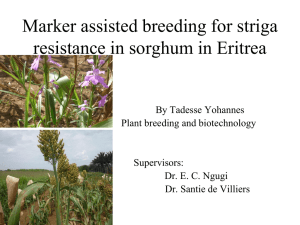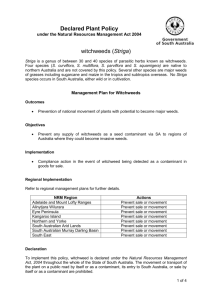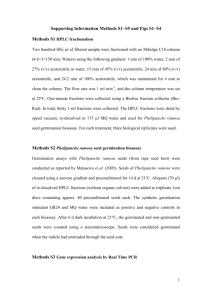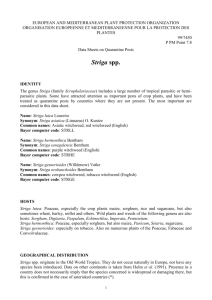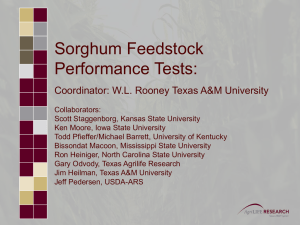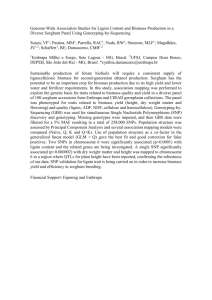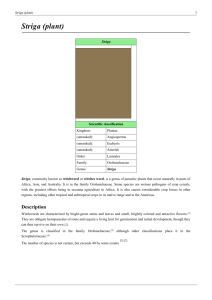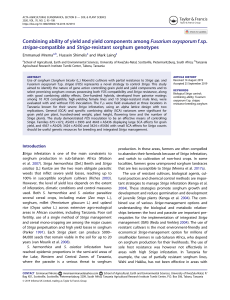Sorghum bicolor
advertisement
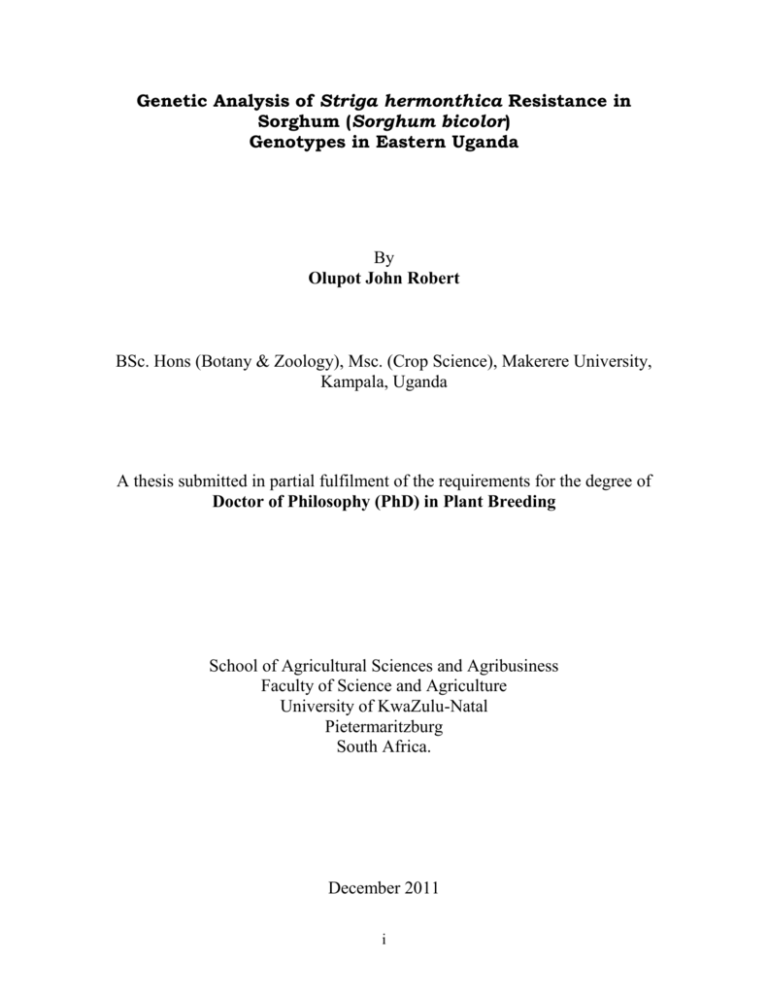
Genetic Analysis of Striga hermonthica Resistance in Sorghum (Sorghum bicolor) Genotypes in Eastern Uganda By Olupot John Robert BSc. Hons (Botany & Zoology), Msc. (Crop Science), Makerere University, Kampala, Uganda A thesis submitted in partial fulfilment of the requirements for the degree of Doctor of Philosophy (PhD) in Plant Breeding School of Agricultural Sciences and Agribusiness Faculty of Science and Agriculture University of KwaZulu-Natal Pietermaritzburg South Africa. December 2011 i Thesis Abstract Sorghum (Sorghum bicolor) is the third most important cereal food crop in Uganda. However, the parasitic weed Striga hermonthica severely constraints its production. The use of Striga resistant sorghum varieties may be one of the most feasible ways of managing the Striga problem. A series of studies were carried out with the overall objective to develop new sorghum genotypes that are resistant to Striga and high yielding in Eastern Uganda. Initially, a participatory rural appraisal (PRA) was carried out with the main objectives to study the current constraints faced by farmers in sorghum production and determine their preferences for new sorghum varieties. Secondly, fifty different African sorghum accessions were evaluated to determine phenotypic and genotypic variability for Striga resistance and identify suitable parents to be used in breeding for new Striga resistant and high yielding sorghum genotypes. Thirdly, a genetics study was conducted to determine gene action responsible for Striga resistance and sorghum yield in new sorghum genotypes. Finally, laboratory studies were carried out to identify specific mechanisms of Striga resistance available in new sorghum genotypes and their parents. During the PRA, Striga was identified as the main constraint limiting sorghum production in Eastern Uganda, followed by insect pests. Farmers indicated preference for red gain sorghum with erect and compact heads, a plant height of 1.5m and a maturity period of around three months, as well as Striga resistance and drought tolerance. From farmers’ own assessments, the individual field surveys and soil seed bank analyses that were carried out, the degree of Striga infestation in farmers’ fields was found to be high. Both phenotypic and genotypic factors contributed significantly to the variability observed among the African sorghum accessions with respect to Striga resistance and sorghum crop performance indicating that Striga resistance can be improved through selection. However, techniques that minimise environmental effects need to be employed in order to improve on heritability. The values for genetic coefficient of variation (GCV) and genetic advance (GA) indicated that genetic gain for Striga resistance could be achieved by selection based on area under Striga severity progress curve (AUSVPC), area under Striga number progress curve (AUSNPC) and individual Striga emergence counts. The sorghum accessions SRN39, Brhan, ii Framida, Gubiye, Wahi, P9407 and N13 were found to be resistant to Striga hermonthica. These accessions consistently showed low AUSNPC, AUSVPC, and individual Striga emergence, Striga vigour and severity indices. These accessions could be used as sources of Striga resistance genes when breeding for Striga resistance in sorghum. In the study to determine gene action responsible for Striga resistance and sorghum yield, significant genetic variation for Striga resistance and sorghum yield parameters was observed among the new sorghum genotypes and their parents. The sorghum parental lines: Brhan, SRN39, Hakika and Sekedo consistently had negative GCA effects for AUSNPC and AUSVPC, while SRN39 and Hakika additionally had negative GCA effects for Striga vigour, indicating that they were effective in transferring Striga resistance into their progeny. The new genotypes: SRS1608, SRS3408, SRS2408, SRS4609, SRS3108, SRS2908, SRS2609, SRS609 and SRS1708 had negative SCA effects for AUSNPC, AUSVPC and Striga vigour meaning that they were resistant to Striga. Sorghum parental lines: Sekedo, Brhan, Framida and Hakika had positive GCA effects for head length, meaning that they increased head length in their crosses. The genotypes: SRS3408, SRS5309, SRS1608 and SRS2908 derived from the above parents had the longest heads compared to other progenies, which were on average, 20% longer than their parents. The genotypes: SRS609, SRS1408, SRS2608 and SRS3408 were the highest grain yielders and yielded 11-51% better than the highest yielding parent (Sekedo) under the non Striga environment. The parental lines; Sekedo, Brhan and Framida had positive GCA effects for grain yield indicating that they could act as sources of genes for grain yield increase. The genotypes; SRS609, SRS4609 and SRS2908 had large positive SCA effects for grain yield. The relative contributions of GCA effects to the observed genotypic variances were 80.5%, 43.3%, 65%, 92.6% and 53.2% for AUSNPC, AUSVPC, Striga vigour, sorghum head length and plant height respectively. This shows that additive gene action was important in controlling Striga resistance, sorghum head length and plant height in the present sorghum populations. iii Laboratory studies aimed at investigating the specific mechanisms of Striga resistance available in new sorghum genotypes found that two new sorghum genotypes, SRS1608 and SRS1208 expressed both the low germination stimulant character and low haustoria initiation as mechanisms of resistance to S. hermonthica. The sorghum genotypes, SRS2808 and SRS1108, and two fixed lines, Brhan and Hakika expressed only the low germination stimulant character, while the genotypes, SRS608, SRS3408, SRS4109 and SRS2308 expressed only the low haustoria initiation mechanism. The inheritance patterns of the low germination stimulant character in the present sorghum genotypes varied. In some genotypes, it appeared to be controlled by a single gene while in others; it appeared to be controlled by more than one gene. iv
